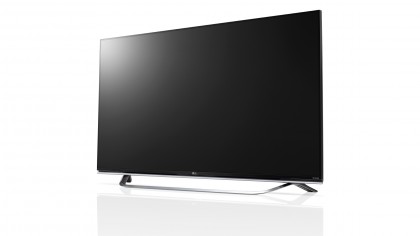Why you can trust TechRadar

Picture performance falls on the right side of impressive. Fine detail performance is good. There's a crispness to its upscaled 2160p picture that is entirely convincing, while colour fidelity is excellent. The set has plenty of dynamics on tap.
There's a tactile level of detail evident in Daredevil (Netflix 4K). Fabrics have weave and density, skin tones are painfully bruised and realistic. It's as if this TV grants viewers some iota of Matt Murdoch's supersense. The set does a fantastic job painting detail into the shadows of Hell's Kitchen. The image is gritty and compelling.
The set doesn't have the best upscaling in its class, but there's no doubt that it puts every 2160p pixel onscreen.
The Expendables 3 (Blu-ray) opens with a big close up of Stallone's grizzled face. Grimy and bathed blue and red, it looks positively hyper-realistic. There's no evidence of pixel structure in the image, even when viewed immodestly close.
Bright white highlights in Stallone's eyes ping from the screen.
Fade to black
The screen offers a passable black level, particularly when viewed in a room with ambient light. While it can't achieve the kind of absolute black we've seen on LG's own OLED screens and previously on high-end plasma displays, it does maintain a consistent dark grey, particularly when the Black level setting is kept to Low, rather than High.
The backlight is not entirely even, although any discrepancies that result are not immediately evident onscreen.
Sign up for breaking news, reviews, opinion, top tech deals, and more.
Motion slickness
Where it does somewhat falter though is motion handling.
This is a common complaint of LG's TruMotion picture processing engine. One simple way to reduce motion artefacts is to turn off TruMotion all together, but this has a negative effect on subjective clarity.
The Smooth and Clear settings restore detail, but introduce motion artefacts around moving objects – horizontal pans are smooth with good detail retention.
The Clear Plus mode delivers excellent moving detail at 6.5 ppf (pixels per frame), but there's a noticeable drop in brightness. There are motion artefacts, but perhaps they're not as noticeable as those found on the regular Clear setting. This could be a good choice for sports fans.
Strangely though not a single TruMotion mode warrants genuine enthusiasm.
Ultimately, I found the best option was to use the customisable User mode (something most buyers simply won't bother with). This has variable de-judder and de-blur, and provides the cleanest images.
Set de-judder at between 5-7, and de-blur at 0. Motion artefacts are reduced to almost zero and there's a little motion blur during pans, which combats that rather cheap-looking soap opera effect.
The result is pleasingly cinematic.
The right angle
While this IPS panel is bold and punchy to watch, off angle viewing is poor. The screen loses a huge amount of contrast and colour if you sit too far to the edge. You really need to park square on for the best results.
Also ensure you engage Just Scan for the aspect ratio, as it's not a default and you'll be missing picture content without realising it.
Picture presets comprise Vivid, Standard, Eco, Cinema, Sports, Game and Photo. There are also dual ISF Expert modes. Standard and Cinema are the go-to options. You can fine tune these with individual Backlight, Contrast, Brightness and Sharpness adjustments.
Power consumption for such a large panel is excellent. Displaying 100 percent colour bars, the TV draws a meagre 67w from the mains; a 100 percent white screen requires just 65W.
3D for me
The screen is 3D compatible, naturally. With regular viewing I've become quite a fan of passive polarised 3D, particularly when implemented on a 4K panel – not least because there's no appreciable resolution drop.
However, this panel is infuriatingly directional. Unless you're viewing three dimensional antics square on, you'll suffer significant double imaging.

For this audition, the set was low to my seating position, only by a few degrees, but this was enough to make onscreen detail in the lower half of the screen a visual mess.
The menu for Tangled, which is a great torture test for 3D TVs, becomes completely unreadable if you're out of alignment. Once you do square up, the 3D picture becomes comfortable to watch – but that acceptable viewing angle takes some finding.
Two pairs of polarised glasses are included in the box. However it's easy to add more. Those RealD 3D specs you get at your local cinema will work just fine.
Surprising sound quality
Audio quality is better than you might expect from the ultra thin form factor.
The speaker drivers, which are slightly angled within to project onto the reflector, do a decent job emulating front-firing sound. What actually looks like a slick cosmetic trim is actually a sonic reflector, and this deception works rather well.
There are six sound modes to choose from: Standard, Cinema, News, Sports, Music and Game.
You'll notice differences here in terms of bass, dynamics and volume, so it's worth experimenting. That said, you'll probably still want to migrate to a separate sound system sooner rather than later.

Steve has been writing about AV and home cinema since the dawn of time, or more accurately, since the glory days of VHS and Betamax. He has strong opinions on the latest TV technology, Hi-Fi and Blu-ray/media players, and likes nothing better than to crank up his ludicrously powerful home theatre system to binge-watch TV shows.
